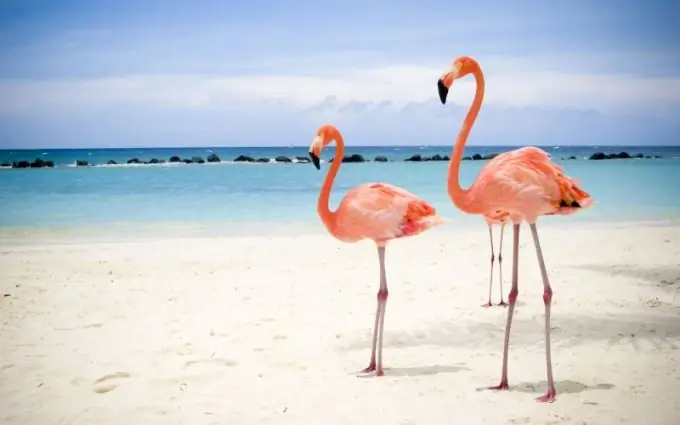In order to depict a flamingo, you can use the technique of drawing birds with the help of auxiliary geometric shapes, and then add the sketch with the characteristic features of this strange bird.

It is necessary
- - paper;
- - a simple pencil;
- - eraser;
- - paints or colored pencils;
- - brushes.
Instructions
Step 1
Start your drawing by constructing auxiliary geometric shapes, they will set the basic proportions of the flamingos. Draw an oval, place it horizontally, later it will become the body of a bird. Draw a curved line extending from one of its ends. Remember that the flamingo's neck is very mobile, it can be lowered, for example, towards the water, or raised high up. The size of the line should be 1.5 times the length of the oval. In the lower part of the body, approximately in the middle, mark two points, draw two straight lines down, these will be the legs. Their length is twice the widest part of the oval.
Step 2
Draw the head of the flamingo. To do this, first outline an elongated oval at the end of the neck, select a massive downward beak. Its size corresponds to the size of the head. Draw a line separating the top of it from the bottom, while it should not be located exactly in the middle, but slightly shifted up. Draw a small round eye in the middle of the oval. Draw two lines from the eye to the beak to outline the area devoid of feathering.
Step 3
Outline the curve of the neck with smooth lines.
Step 4
Select the back of the flamingo with a convex line. Draw a smooth transition from the neck to the body. Finish the body with large dense feathers, they are not very long in the tail, so you should not take them far beyond the boundaries of the auxiliary oval. Follow the direction of the feather growth.
Step 5
Draw the legs. Remember that they are very delicate. Select the knobby knees around the middle. The bird's legs should not be completely straight; after articulation, the direction of the leg can be slightly changed. Finish the limbs with your fingers, between the front, depict a leathery membrane.
Step 6
Start coloring. For feathers, you can choose any color - from completely white to scarlet, the color is determined by the amount of food containing carotene. On the flight feathers, select a few large black strokes. Also paint the end of the beak (about half) in black, select a line between its upper and lower parts. For the legs, use a grayish color, paint the knees and toes with a light pink.






